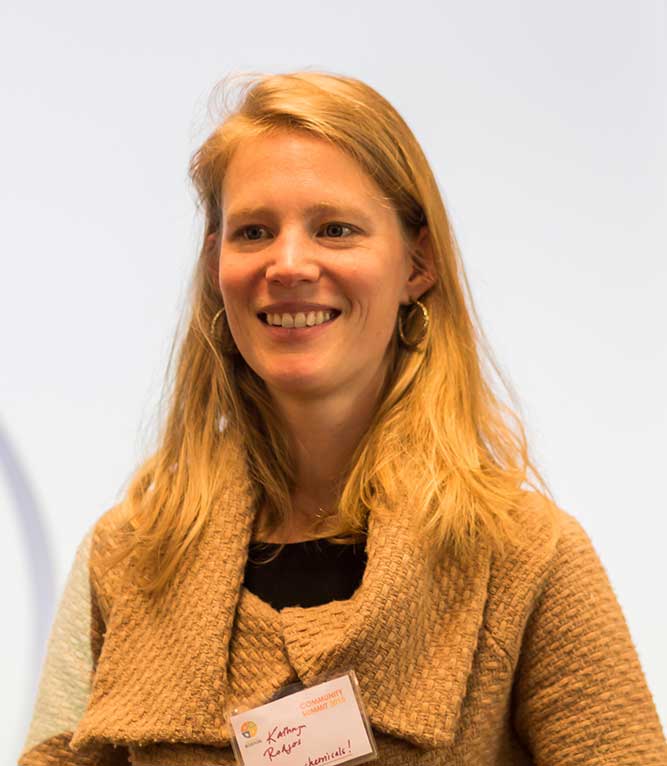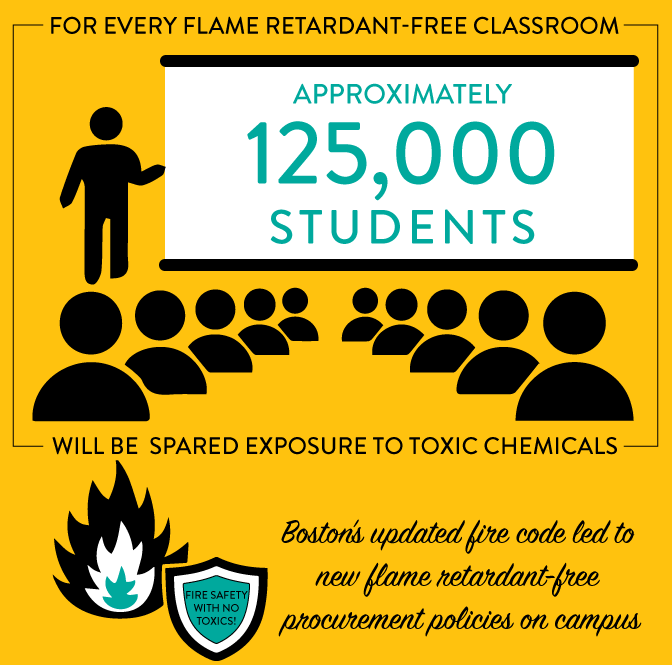Fighting Toxic Flame Retardants with Strong Science
“By shining the powerful light of research on not just one but an entire group of toxic chemicals found in our indoor environment, we’re working to ensure a future where no one gets sick from toxic chemicals.” – Kathryn Rodgers, Staff Scientist for Silent Spring Institute
Being a firefighter has its risks, but cancer shouldn’t be one of them. During a fire, firefighters breathe in high levels of toxic chemicals, including cancer-causing flame retardants, from furnishings when they burn. It’s no surprise then that these first responders also have some of the highest rates of cancers of any population. Concerned about their members, professional firefighting associations have been working to stop companies from adding toxic flame retardants to consumer products here and abroad.
The problem, however, isn’t confined to burning buildings. According to Kathryn Rodgers, a scientist at Silent Spring Institute (SSI), a Newton, MA-based nonprofit scientific research organization that investigates the links between environmental chemicals and health, “We’re all exposed to these chemicals every day. Flame retardants leach out of the products in our homes and workplaces. Over time, they accumulate in indoor dust, and they get into our bodies, where they can cause cancer, disrupt hormones, and affect brain development.”
Sadly, chemical manufacturers continue to produce flame retardant chemicals at volumes that could reach 2.8 million tons in 2018. The kicker is that flame retardants don’t appear to increase fire safety, and are unnecessary since there are effective non-toxic methods such as smoke detectors, sprinklers, and smoking bans.
This has prompted SSI along with many of its partners, including Green Science Policy Institute, and Harvard University Office for Sustainability, to take up arms against this sea of toxic chemicals. By engaging with advocates, lawyers, and other research institutions, SSI has developed a successful strategy to ensure its groundbreaking research leads to policy changes that protect people from exposure to harmful flame retardants.

KATHRYN RODGERS, STAFF SCIENTIST FOR SILENT SPRING INSTITUTE
In collaboration with:
Green Science Policy Institute
Harvard University Office for Sustainability
Center for Health and the Global Environment at the Harvard T.H. Chan School of Public Health
Earthjustice
Clean Water Action
The Groundbreaking Research that Exposed a Coast-to-Coast Problem
In 2003, SSI’s Household Exposure Study revealed high levels of PBDEs, a flame retardant used in furniture, textiles, and electronics, in homes on Cape Cod, Massachusetts. Levels of these chemicals were 10 times higher than those measured in European homes where PBDEs were not widely used.
Says Rodgers, “This was the first time researchers had ever measured PBDE flame retardants in homes in the U.S. and it opened the door to an entire field of study.” In order to meet a flammability standard set by the state of California decades earlier, furniture manufacturers applied flame retardants to all their products. With California’s market being so large, this affected products nationwide.
In California in the 1970s, there was a growing concern about house fires caused by cigarette smoking. Instead of making cigarettes safer, such as cigarettes that self-extinguish, the tobacco industry teamed up with chemical companies to convince the state that the answer was to apply flame retardants to furniture products. In 1975, California enacted a flammability standard, California Technical Bulletin 117 (TB117), which led to the use of flame retardant chemicals in upholstered furniture coast to coast.
So in 2006, SSI took their investigation to California where they found levels of PBDEs in house dust were 200 times higher than in Europe. Even worse, compared with the national average, Californians had double the amount of PBDEs in their blood.
Although PBDEs had been phased-out in 2005, when SSI went back in 2011 to re-test the same California homes they’d looked at previously, they found the chemicals had been replaced by a hazardous mixture of flame retardant called Firemaster 550. They also found high levels of TDCIPP (also known as “chlorinated-tris”)—the same flame retardant that manufacturers removed from children’s pajamas back in 1978 after research by Dr. Arlene Blum, director of Green Science Policy Institute, showed the chemical causes cancer.
“Tragically, as soon as one toxic chemical is banned, the chemical companies find a way to replace it with another bad actor,” says Rodgers.
SSI and its partners quickly recognized this unscrupulous tactic, and armed with this new evidence, sounded the alarm, loud and clear, convincing the state of California to change TB 117 to no longer require flame retardants in furniture. A result of this new standard, which was revised in 2013, consumers today can now purchase flame retardant-free furniture.
“Tragically, as soon as one toxic chemical is banned, the chemical companies find a way to replace it with another bad actor,” says Rodgers.
A First Victory on Campus—Harvard University
Over the years, SSI has partnered with groups around the country to change policies at the city, state, and federal levels. And they’ve seen firsthand how big consumer groups, such as universities and colleges, can use their purchasing power to shift markets toward safer products.
In 2014, SSI started the Healthy Green Campus project to encourage colleges to include hazardous chemicals in their sustainability practices on campus. As part of that effort, Rodgers and her team collected and analyzed nearly 100 dust samples from dormitories on two different college campuses. They detected 47 different flame retardants and measured some of the highest dust levels of flame retardants ever recorded in residential spaces.
Seeing that policies targeting single chemicals fail to protect the public, Rodgers and her team decided to take aim at the entire class of flame retardants—a strategy that Green Science Policy Institute promotes through its “Six Classes” of chemicals program. The upshot? When the City of Boston changed its fire code to allow flame retardant-free furniture in the city’s public spaces, Harvard University became the first school to specify and procure fire-safe products free of all flame retardant chemicals.
Today, through the Healthy Green Campus project, Rodgers and her team are working to engage more campuses. “By raising awareness of the link between toxic chemicals and health on college campuses, we hope to inspire students and schools to create healthy and productive learning environments.”
A Strategy For A Healthier Future
In 2017, SSI published their critical research on flame retardants found in college dorms in the Journal of Environmental Science & Technology. That same year, Rodgers testified before the U.S. Consumer Product Safety Commission in support of a petition, led by the nonprofit law firm Earthjustice, to eliminate an entire class of flame retardants from children’s products, mattresses, upholstered furniture, and electronics. The CPSC ultimately voted in favor of the petition, representing a huge victory for public health.
And, since college students appear to be highly exposed to flame retardants, SSI and friends have fired up more young leaders to embrace new practices that eliminate these chemicals on campus. Thus far, Rodgers and her team have advised six colleges on how to eliminate and reduce exposures to flame retardants.
SSI is also targeting a class of highly fluorinated chemicals called PFASs on college campuses. These harmful chemicals are used in a wide range of consumer products from stain-resistant textiles to grease-proof food packaging. Instead of going after one toxic chemical at a time, Rodgers and her collaborators are also approaching them as a class. “It’s the best way to prevent the chemical industry from simply swapping out one toxic relative for another,” says Rodgers.
Translating science into policy to protect human health is what the scientists at SSI strive to do every day—it’s what they do best. “At the end of the day, we all have the right to live in a healthy environment where no one gets sick from toxic chemicals,” says Rodgers.
Instead of going after one toxic chemical at a time, Rodgers and her collaborators are also approaching them as a class. “It’s the best way to prevent the chemical industry from simply swapping out one toxic relative for another,” says Rodgers.
The RESULTS!

